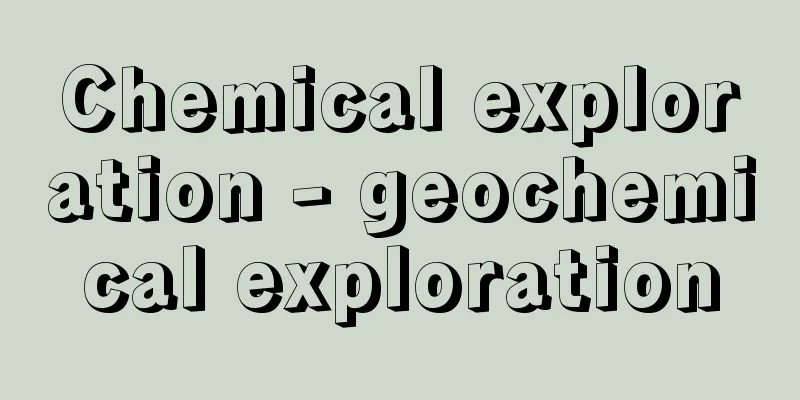Chemical exploration - geochemical exploration

|
A mineral exploration method that estimates the possibility of mineral deposits from the distribution of trace elements (components) that are thought to originate from underground mineral deposits by analyzing natural water, river sediments, glacial deposits, soil, rocks, plants, soil gas, and steam on the surface of the earth. It is also called geochemical exploration. It is generally known that around mineral deposits, the constituent elements of the ore body (components) are dispersed during the formation of the deposit or during the weathering process after formation, and often form a high concentration zone (called a dispersion halo). In chemical exploration, anomalies in this dispersion halo are comprehensively analyzed based on the topography, geology, geological structure, and mineral deposit science knowledge of the exploration area, and used as a clue for exploration. In addition, specific elements (components) analyzed to estimate the presence of a specific mineral deposit are called indicator elements. In chemical exploration, indicator elements are selected according to the type of target deposit and the condition of the sample. For example, mercury, zinc, gold, silver, and arsenic are used for gold and silver deposits, copper, lead, zinc, mercury, and sulfate ions for copper-lead-zinc deposits, mercury for mercury deposits, hydrocarbons such as methane and ethane, carbon dioxide, nitrogen, hydrogen, and helium for oil and natural gas deposits, and mercury, arsenic, and helium for geothermal resources. In addition to the traditional colorimetric analysis, instrumental analysis has been developed recently, and optical emission spectroscopy, X-ray fluorescence analysis, atomic absorption spectrometry, gas chromatography, mass spectrometry, etc. are used for trace element analysis. In actual analysis, the analytical method is selected according to the type and properties of the sample and indicator elements, as well as the required accuracy. In recent years, computers have been introduced into data analysis, making it possible to process a large number of analytical values quickly. Historically, chemical exploration is an exploration technique that developed as one of the applied fields of geochemistry. It was first developed independently in the Soviet Union and Scandinavia in the mid-1930s, and after World War II it became widely used and developed in other countries, including the United States, Canada, and the United Kingdom. [Minato Taneo] Source: Shogakukan Encyclopedia Nipponica About Encyclopedia Nipponica Information | Legend |
|
地表の自然水、河川堆積(たいせき)物、氷河堆積物、土壌、岩石、植物および土壌ガス・蒸気などの分析を行って地下に存在する鉱床に由来すると考えられる微量元素(成分)を定量し、その分布状態から鉱床賦存の可能性を推定する探鉱法。地化学探査ともいう。一般に鉱床周辺には、鉱床生成時あるいは生成後の風化過程において鉱体構成元素(成分)が分散し、しばしば高濃集帯(分散ハローという)を形成することが知られているが、化学探査では、この分散ハローの異常を、探鉱地域の地形、地質、地質構造、鉱床学的知識などから総合的に解析し、探査の手掛りとする。また、特定の鉱床の存在を推定するために分析される特定の元素(成分)を指示元素とよんでいる。 化学探査の実施にあたっては、指示元素は目的鉱床の種類や試料の状態によって選択される。たとえば金・銀鉱床の探査には水銀、亜鉛、金、銀、ヒ素、銅・鉛・亜鉛鉱床には銅、鉛、亜鉛、水銀、硫酸イオン、水銀鉱床では水銀、石油・天然ガス鉱床にはメタン、エタンなどの炭化水素、二酸化炭素、窒素、水素、ヘリウム、地熱資源には水銀、ヒ素、ヘリウムなどが用いられる。 微量元素分析法としては、従来から用いられている比色分析に加えて、最近は機器分析による方法が発達し、発光分光分析、蛍光X線分析、原子吸光分析、ガスクロマトグラフィーgas chromatography、質量分析などが利用されている。実際の分析にあたっては、試料および指示元素の種類や性質、また必要精度によって分析方法が選ばれる。データ解析についても、近年コンピュータが導入され、多数の分析値が迅速に処理できるようになった。 なお、歴史的にみると、化学探査は地球化学の応用分野の一つとして発展した探鉱技術で、最初1930年代の中ごろ、ソ連およびスカンジナビアで独自に開発され、第二次世界大戦後に広くアメリカ、カナダ、イギリスなど各国でも行われるようになり発達した。 [港 種雄] 出典 小学館 日本大百科全書(ニッポニカ)日本大百科全書(ニッポニカ)について 情報 | 凡例 |
<<: Chemical seasoning manufacturing industry
>>: Chemical exploration method
Recommend
Trakai (English spelling)
A town in southeastern Lithuania. It is located ab...
Drache
...The name "tako" spread from Edo duri...
Erwin Chargaff
1905‐2002 Austrian-born biochemist. After graduati...
Humorous songs - Conversational songs
⇒ Scherzo Source: About Shogakukan Digital Daijise...
Moving branch point
...A global solution can be obtained by analytica...
ANSI - Ansi
American National Standards Institute. A non-profi...
Naven
...they depended on the men they met...," he...
Chateau d'eau (English spelling) chateau de eau
…The Adamawa Plateau, which divides the country i...
Mexican moccasin (English spelling)
...It is found in Taiwan, southern China, and Ind...
Official History
Of all the historical books of China throughout hi...
Mona monkey (English spelling)
A medium-sized monkey of the genus Cercopithecus, ...
Akiru Plateau
…In 1955, the three villages of Higashiakiru, Nis...
Abū Tammām (English spelling) AbuTammam
…Abu Nuwas was a poet of genius who was not influ...
Trichoptera
...A general term for insects in the order Tricho...
Irozaki Lighthouse
A lighthouse in Minamiizu-cho, Kamo-gun, Shizuoka ...









